With customer service requirements becoming largely digital, leveraging homegrown CRM adoption emerges as the solution for enhancing customer relationships and achieving wider digital transformation (DX). As the customer landscape evolves, firms achieve CRM success by managing data efficiently and providing a personalized customer experience.
Homegrown CRM solutions are becoming increasingly popular for businesses looking for a tailored fit to handle their unique requirements. They allow organizations to customize their CRM system and make it fit for purpose.
According to Gartner, the Customer Relationship Management (CRM) software market is expected to grow by over 14% by 2025.
Homegrown CRM solutions can help organizations enhance the customer journey, allowing salespeople to stay on-top of prospects, leads and opportunities and progress them along the sales funnel. By taking the time to better understand customer preferences and behavior, organizations can provide an experience uniquely tailored to their needs. The digital adoption of homegrown CRM systems is essential to the customer experience, and will be a key tool for driving business value in 2023 and beyond.
Customers expect seamless user experiences, personalized content, and timely communication across all channels. They also want to be able to access customer service 24/7, with trouble-free navigation and efficient resolution of their queries.
Organizations need to be able to accurately capture, store and analyze customer data for them to provide the best service possible. Homegrown CRM solutions offer the flexibility to enable businesses to build comprehensive customer profiles that will allow them to understand consumers better and deliver more relevant and personalized experiences.
- What Is Homegrown CRM Adoption?
- Why Does CRM Adoption Matter?
- CRM Adoption Statistics For 2023
- Homegrown CRM Adoption Challenges:
- Homegrown CRMs and The Legal Profession
- Tracking CRM Adoption Rates with Metrics
- Proven Strategies and Practices For Unlocking CRM Adoption to Its Full Potential
- Homegrown CRMs: Communication Is Key
- The Future of Homegrown CRM Adoption: Automation
What Is Homegrown CRM Adoption?
Homegrown customer relationship management adoption can be characterized by the number of companies or end-users utilizing a CRM system compared to the total amount bought.
Traditional CRM software often fails to be widely accepted due to its convolutedness, user-unfriendly aspect, vague instructions, and laborious onboarding process.
The ultimate test for deal team leads and sales managers is fostering widespread adoption of their CRM platform. It’s the individual users who will determine if a deployment was a successful or wasted effort. If they are unwilling to accept the new tool into their workflow, user adoption rates could be hindered significantly.
A CRM success consultant can provide guidance and support to sales teams as they adjust to the new system. This includes performing an initial analysis of the current state of the company’s data, helping to design processes and reports tailored to fit their specific needs, establishing training and support channels for users, and providing ongoing optimization of the system.
Offering support resources, creating reports and dashboards to share information and progress, and scheduling regular check-ins with team leads are all key strategies to ensure successful adoption.
For this reason, it’s essential that everyone involved wholeheartedly embraces the CRM system in order for its potential to be realized.
Why Does CRM Adoption Matter?
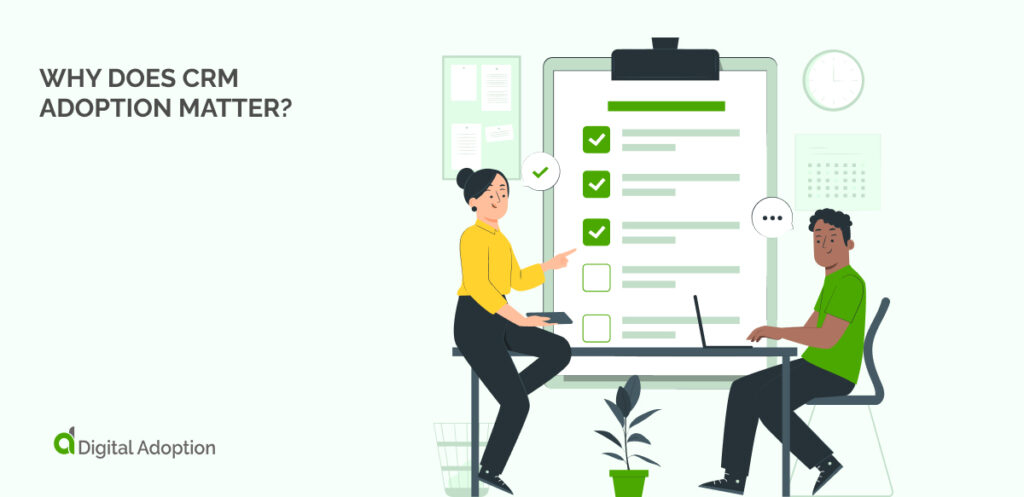
Enhancing CRM adoption should be ongoing as the company’s goals change and new technologies enter the marketplace. Regular feedback from users can help identify areas of improvement to help define CRM success.
If your team’s end-user CRM adoption rate is low, it can spell disaster for your business efficiency and even cause a decrease in revenue. One of the main motivations behind integrating a CRM system is that data consolidation and maintenance are simply too advantageous to ignore.
Achieving high CRM adoption rates can give you the upper hand in terms of increased productivity, quicker decision-making, and shorter sales cycles. Getting your team to embrace traditional CRMs is often like pulling teeth. To help solve this issue, we have highlighted below the top reasons dealmakers and salespeople dislike using their CRM and strategies to drive successful adoption.
The first step to mastering CRM adoption, whether transitioning your company’s software or attempting to standardize an existing platform, is understanding the difficulty of achieving it. With this knowledge and comprehension, you can start developing a strategy for success.
CRM Adoption Statistics For 2023

The following statistics demonstrate the importance of CRM adoption and the impact it has on businesses:
- A staggering 70% of CRM deployments fail to meet expectations, leaving organizations without the tools they need for success. (Source: SKUId)
- Some companies have experienced multiple deployment failures, ranging from two to three. (Source: C5 Insight)
- By leveraging the power of a CRM system, you can exponentially increase customer retention rates by up to 27%. (Source: Trackvia)
- A whopping 64% of companies believe that CRM technology is either highly impactful or influential in their success. (Source: LinkedIn)
- Most businesses report that their CRM has granted them greater access to data, with 72% being an exact figure. (Source: Resco.net)
- Nearly half of the businesses have experienced improved customer satisfaction and retention thanks to the implementation of a CRM. (Source: Capterra)
Homegrown CRM Adoption Challenges:
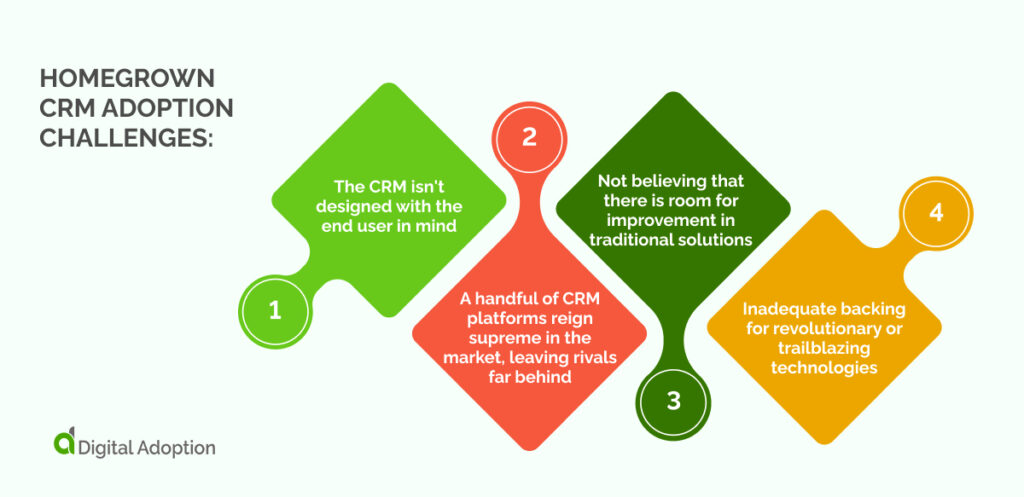
In recent years, the customer relationship management software market has exploded and is now one of the largest software markets.
The ubiquity of CRM systems does not equate to their successful integration. Low adoption rates result in incomplete records stored within a low-value system, consequently perpetuating the cycle of reduced usage and deployment failure at large. With this being said, it is evident that organizations must prioritize utilizing CRMs efficiently to avoid such shortcomings altogether.
Here are some of the most significant CRM adoption obstacles and strategies your team can utilize to overcome them:
1. The CRM isn’t designed with the end user in mind
Many CRM vendors tailor their platforms to meet the needs of sales managers and leaders, as they are usually the ones making purchasing decisions. To this end, these suppliers focus on optimizing features in relation to reporting, pipeline visibility, and forecasting – all crucial elements for decision-makers.
Unfortunately, this leads to a lower priority on providing an easy-to-use platform for team members who rely on the CRM. Many existing systems are not user-friendly or require too much time from salespeople and deal teams, making them frustrated with the process.
As data entry is an oft-frustrating task for those managing customer relations, 71% of CRM users feel that too much time is devoted to this endeavor. This has led many people to avoid their CRMs entirely! Additionally, 79% of potential opportunity information collected by sales reps never makes it into the system, thus leaving a void in overall content within the framework.
A significant issue with standard CRMs is that they track accounts instead of relationships. All clients, regardless of their complex or unique needs, receive the same treatment in traditional sales CRM ecosystems – like transactions.
Industries such as venture capital, private equity, and investment banking need better-designed systems to comprehend more intricate communication dynamics and accurately measure customer relations; unfortunately, present-day platforms cannot provide this kind of insight yet.
2. A handful of CRM platforms reign supreme in the market, leaving rivals far behind
Numerous market sectors are highly concentrated, where a single corporation or a small group of organizations possess the majority share of that specific product or service. The customer relationship management software market is no different.
According to G2, the top five CRM solutions currently in use are Salesforce, Microsoft Dynamics 365, SugarCRM, Oracle CX, and Zoho CRM. Together, these five hold a remarkable 57% of the market share, leaving the remainder of the solutions to fight for the remaining market share.
In the world of big corporations and dominating brands, it’s easy to assume that a market leader is an optimal solution in any given situation. However, this could not be farther from the truth. Choosing an industry giant may seem simple, but you’ll soon realize that they don’t always meet your needs or expectations.
3. Not believing that there is room for improvement in traditional solutions
CRM software can be a powerful tool that helps to improve customer relations and streamline sales operations. Unfortunately, its capabilities are limited if it isn’t used correctly or more efficiently.
Organizations should leverage the latest and greatest technologies, such as machine learning and artificial intelligence, to gain deeper insights into their customers’ behaviors and needs. This can be used to personalize the customer experience, increase sales conversions and drive greater ROI.
Additionally, organizations need to keep up with the ever-changing technology landscape. Staying ahead of the curve is essential when using CRMs effectively – this allows teams to gain an advantage over their competitors in reaching customers and optimizing operations.
Although most businesses have yet to adopt CRMs, that has not stopped a staggering 70-80% from being content with their current setup – even if it means relying on old-fashioned spreadsheets. The status quo appears good enough for many companies hesitant about making changes in this area.
This mindset leaves companies vulnerable to missing out on opportunities that could provide them a massive benefit compared to Salesforce and the well-known CRM suppliers.
4. Inadequate backing for revolutionary or trailblazing technologies
When an organization neglects to provide the necessary training after implementing a CRM, it can lead to decreased support for the platform and frustration among employees. This results in diminished acceptance of their new CRM, which can have drastic implications for its success. Organizations can maximize adoption rates by equipping team members with appropriate instruction and ensuring everyone is comfortable using their new system.
Post-implementation customer support and decision-support systems are essential pieces of CRM software. Users must be able to ask questions, address issues, and become familiar with the product’s features. If they don’t receive adequate help, it will lead to inadequate usage or even disinterest in the platform. People who switched from prominent market platforms usually mentioned that their experience was severely hindered due to a lack of proper technical assistance, feeling like just another user in a crowd.
Homegrown CRMs and The Legal Profession
The legal profession has long relied on homegrown CRM solutions for daily operations. These systems are usually tailored to the specific needs of a law firm, making them expensive and difficult to replace.
Many of these legal CRMs lack the sophistication or scalability of a modern, cloud-based system, but they often contain data invaluable to the firm’s operations. As such, it can be difficult for firms to migrate away from their existing system and invest in a new one.
Leading global law clients have successfully migrated to a cloud-based CRM solution to streamline processes and improve efficiency. The transitioning process may involve data cleansing, setting up workflows, establishing user rules and permissions, and developing user training modules.
Law practice management consultants can help firms analyze their current processes and develop strategies to transition to a new CRM solution. Careful planning of the migration process and training and support for users will ensure that the switch is successful.
Legal teams can improve data security and access, streamline processes, and enhance collaboration and communication by investing in modern homegrown CRM systems. With the right support and guidance, firms can ensure the successful adoption of their new CRM system.
Law office technology experience is critical when it comes to successful CRM adoption. A legal consultant with a deep understanding of the unique requirements and challenges of the profession can help firms transition away from their existing system and onto a more modern, cloud-based solution.
Tracking CRM Adoption Rates with Metrics
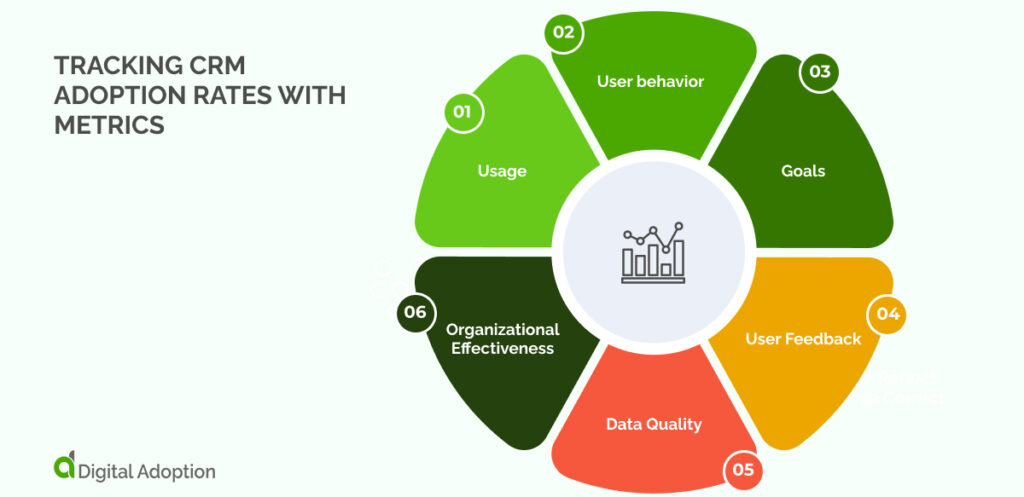
The following metrics can be used to measure CRM adoption rates and evaluate an organization’s progress toward full acceptance:
1. Usage
The clearest way to gauge the effectiveness of your CRM is by tracking login rates. This can tell you who’s logging in and give an idea of how much they’re using it — even if there isn’t a full picture yet. Once that’s determined, you can dig deeper into specific usage patterns for each individual or team member.
2. User behavior
User behavior metrics can help you understand the extent of your team’s interaction with the CRM frequency.
These data points include:
- Increase sales by creating new contacts and opportunities in your CRM.
- Task completion
- Emails sent (if your CRM includes an email feature)
- Deal status updates
3. Goals
Establish objectives for each individual and team utilizing the CRM, track their progress and analyze it routinely. Intelligent CRMs today come with embedded business intelligence solutions that keep an eye on your targets and display them graphically to make determining whether you’re staying in line easier.
4. User Feedback
Invite your team to contribute their thoughts about the CRM and suggest ways for improvement. They will gain a sense of ownership by making them aware that their input is valued.
5. Data Quality
Ensuring your user-entered data is formatted consistently should be a top priority for the success of any CRM. To ensure reliable results, routinely audit the essential information in your contacts and properly evaluate how deals are being moved to appropriate stages. Consistently monitoring these metrics on a monthly basis will help guarantee high-quality performance over time.
6. Organizational Effectiveness
To determine the effectiveness of your CRM, it is imperative to monitor usage rates, user behavior, and data quality over time. With this information, you can track how successful CRM initiatives contribute directly to deals won and organizational growth, providing a clear financial benefit for using a reliable customer relationship management system.
Proven Strategies and Practices For Unlocking CRM Adoption to Its Full Potential
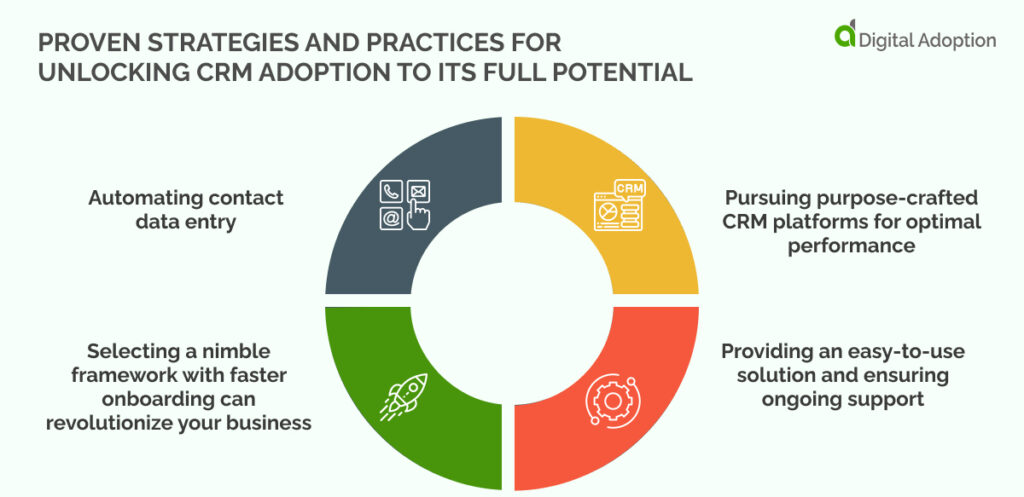
To ensure your team takes full advantage of the customer relationship management platform, you must ensure they understand how it can facilitate their business processes. By applying these strategies, you’ll be giving them a chance to maximize productivity while utilizing this dynamic new tool. This can improve CRM adoption and help amplify your workflow optimization efforts.
Automating contact data entry
Intuitive CRM systems backed by relationship intelligence make data entry a thing of the past – automatically storing information and connections from emails, calendar events, calls, and contact details.
Automated data capture streamlines the process of data entry and contact management, encouraging user adoption rates for CRMs while allowing deal teams to focus on strengthening customer relationships.
Implementing a successful CRM project with high user adoption rates isn’t something that can be done in one day – it needs an appropriate amount of time and effort. Selecting the ideal platform is crucial to guarantee the best experience for your users. Affinity simplifies all business activities into one dependable source through automated data collection and enrichment, ultimately saving hundreds of hours for your team.
Selecting a nimble framework with faster onboarding can revolutionize your business
Taking advantage of a live demo can help you and your team evaluate user-friendly relationship intelligence CRM platforms with real-time data so that when the time comes to switch over, all of your information will already be in place, which saves both deployment and training.
Moreover, today’s advanced CRM systems are designed with the user in mind to expedite deployment and simplify onboarding and training. This makes getting your team members on board easier, which will generate more enthusiasm about using the new CRM system.
Pursuing purpose-crafted CRM platforms for optimal performance
Instead of simply dealing with outdated systems or reluctantly accepting that their CRM will never be any better, savvy deal teams are utilizing modern technologies that cater to the user experience and fit seamlessly into their unique workflows.
By selecting purpose-crafted homegrown CRM platforms designed with specific use cases in mind, they can get the most out of their customer relationship management system and achieve strong user adoption. This allows them to customize their process automation and team collaboration tools to suit their business needs while ensuring compliance with data privacy regulations.
Providing an easy-to-use solution and ensuring ongoing support
Unlocking the highest user adoption rates is as simple as picking a CRM system that’s intuitive, effortless to operate, and requires minimal manual data entry.
A platform accessible from any device, with various user-focused features such as contextual search capabilities and real-time data updates, will help ensure users have an optimal experience.
It’s also important to provide 24/7 support so your team member can get assistance when they need it. By taking the necessary steps to foster successful CRM adoption, you’ll be on the path to driving increased productivity and higher user satisfaction.
These strategies will help ensure that your team utilizes its CRM system to the fullest potential, ultimately helping it save time and money while improving customer relationships. You can get started by automating contact data entry, choosing an agile framework with faster onboarding, and exploring purpose-crafted platforms for optimal performance. Lastly, provide an easy-to-use solution with ongoing support to ensure your team has the best experience possible.
With these strategies in place, you can achieve strong user adoption rates and drive increased satisfaction while unlocking the full capabilities of your CRM system.
Homegrown CRMs: Communication Is Key
Communications training ideas are crucial to homegrown CRM management. A major part of ensuring a successful CRM system is developing effective communication strategies among all users. This can include ensuring everyone understands how to use the system, setting clear expectations for communication frequency and content, and troubleshooting any issues that arise.
Global industry director of sales at Oracle, Chris Dinsmore, suggests that businesses should “communicate the value of the CRM system to employees, provide them with training on how to use it, and make sure everyone is using the same methods of data entry and reporting.” Training ideas may include holding seminars, hosting webinars, providing live demos and hands-on practice sessions, or having a dedicated CRM user group to provide support.
CRM implementation processes should also be taken into consideration. Communication training can help ensure that everyone understands the steps being taken and what is expected of them during the implementation process. The CRM vendor can provide detailed information about the process and how it impacts each user’s role. Additionally, having regular meetings to discuss any questions and keep everyone updated on the progress can help ensure a successful implementation.
CRM deployment and maintenance also require effective communication. Regular status reports and updates to all users can ensure everyone is on the same page and prevent any issues from arising due to miscommunication.
Free language English adoption tools should be used to support the communication training. English language proficiency is a must if everyone needs to understand and use the CRM system properly, so providing users with guidance on how to adopt the language is essential.
Ultimately, communication training ideas should be tailored to each organization’s needs. It’s important to tailor training strategies to each organization’s specific system, user roles, and operational processes so that everyone is properly prepared to use the CRM system and get the most out of it.
The Future of Homegrown CRM Adoption: Automation
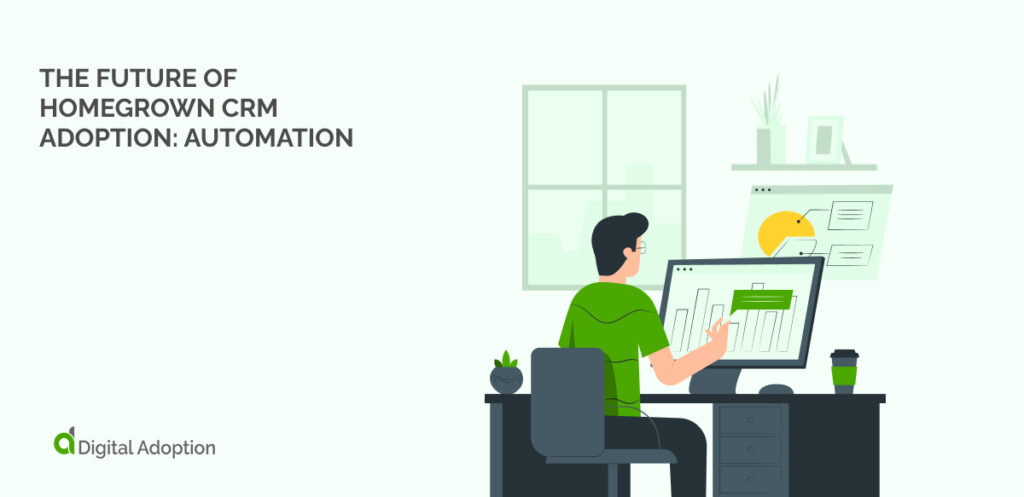
Achieving strong user adoption rates is essential for any successful CRM project. By selecting the ideal platform and leveraging purpose-crafted solutions, your team can unlock its full potential while providing an easy-to-use solution with ongoing support to ensure users have the best experience possible.
Automated data collection, enrichment, and faster onboarding can help revolutionize your business while saving time and money. With these strategies in place, you’ll be well on your way to success.

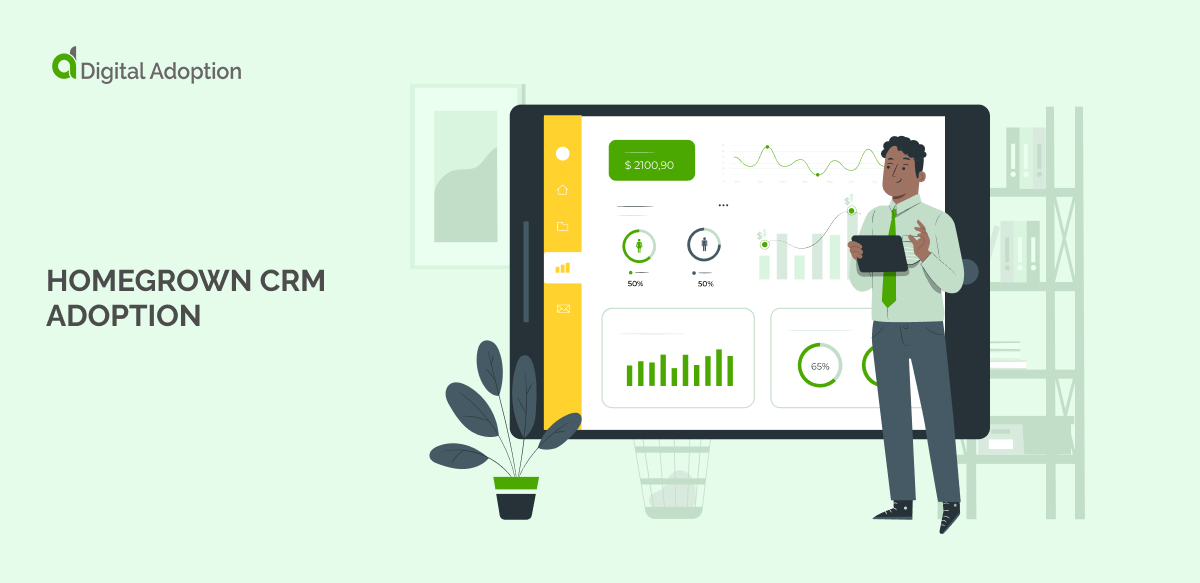



![18 Examples of AI in Finance [2025]](https://www.digital-adoption.com/wp-content/uploads/2025/06/18-Examples-of-AI-in-Finance-2025-300x146.jpg)
![14 Examples of AI in Manufacturing [2025]](https://www.digital-adoption.com/wp-content/uploads/2025/06/14-Examples-of-AI-in-Manufacturing-2025-300x146.jpg)
![29 Examples of AI in Education [2025]](https://www.digital-adoption.com/wp-content/uploads/2025/06/29-Examples-of-AI-in-Education-2025-300x146.jpg)
![15 Examples of AI in Retail [2025]](https://www.digital-adoption.com/wp-content/uploads/2025/06/15-Examples-of-AI-in-Retail-2025-300x146.jpg)



![18 Examples of AI in Finance [2025]](https://www.digital-adoption.com/wp-content/uploads/2025/06/18-Examples-of-AI-in-Finance-2025.jpg)
![14 Examples of AI in Manufacturing [2025]](https://www.digital-adoption.com/wp-content/uploads/2025/06/14-Examples-of-AI-in-Manufacturing-2025.jpg)